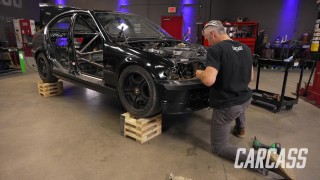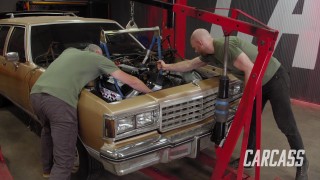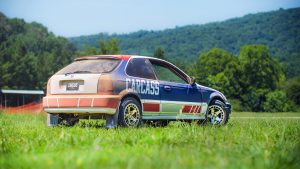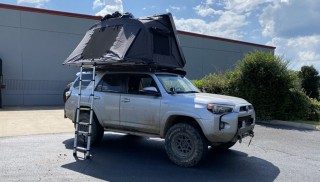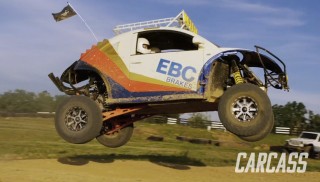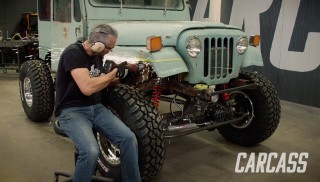Carcass Featured Projects
Carcass Builds
Want more content like this?
Join the PowerNation Email NewsletterParts Used In This Episode
Continental Tire
Continental Extreme Contact Sport Tires
Edwards Ironworkers
Edwards Ironworker & Horizontal Press
Gearstar Performance Transmissions
Level 4 Turbo 400 Transmission
Matco Tools
MATCO Tools are the Official Tool Supplier to PowerNation
Matco Tools
Matco Tools Step Drill
RockAuto.com
Belt Weatherstrip
The Industrial Depot
Tools, Hardware, Shop Supplies
Video Transcript
(Jimmy)>> You're watching Powernation!
(Jeremy)>> Today on Carcass we finish off our Autocross Camaro with an aero package before weaving it in and out of turns on the track. You're watching Carcass.
(Narrator)>> When you want to build something different you turn to Carcass. They transform cars and trucks into one of a kind builds. From street to mud if you dream it they can build it. This is Carcass, a non-traditional speed shop. [ MUSIC ]
(Jeremy)>> Our 25th anniversary Camaro has seen a bunch of improvements since we last took it out to NCM Motorsports Park in Bowling Green, Kentucky. We started by ripping out the old power plant and replacing it with over 400 ponies that we got from the guys down in Engine Power.
(Jimmy)>> And we backed those up with a Gearstar turbo 400 transmission sending all that power to the wheels. And speaking of wheels, we mounted up some Continental Extreme Contact sport tires on some Weld Racing forged wheels we got from Summit Racing.
(Jeremy)>> With all that horsepower we added a little bit of life insurance with the pre-fabbed roll cage, and then we added some racing style seats. Then we directed our attention underneath the vehicle.
(Jimmy)>> We did a suspension overhaul to prevent this thing from steering like a bulldozer on the track. This included adjustable coil overs front and rear, and even a new axle with 3.73 gears.
(Jeremy)>> And finally with the new stance of this combo we took a set of universal fender flares and tweaked them to give our Camaro a fast new look.
(Jimmy)>> To go along with the fender flares we installed on our '92 Camaro we're gonna make a front and rear aero package to match.
(Jeremy)>> In the rear we're gonna get rid of the cheesy spoiler that really wasn't doing much good anyways and replace it with an aluminum spoiler Jimmy and I are going to fabricate to help with rear downforce.
(Jimmy)>> And up here we're gonna make a splitter to help with front downforce and we're gonna make it out of materials you might not have thought you could make a splitter from.
(Jeremy)>> But before we can lay down some serious track times on the course we're gonna have to install the hood that we got from Summit Racing and bolt in the exhaust we got from Holley Performance.
(Jimmy)>> The first thing to come off is that cheesy spoiler.
(Jeremy)>> The spoiler is held on with a couple of easy to find nuts and some that are hidden under some plastic plugs. And what was waiting for us when we pulled off this 28 year old spoiler was well... Oh that's nasty!
(Jimmy)>> To make this job easier we're gonna separate the deck lid from the back glass. After removing the plastic trim from under the deck lid, we unbolted the nuts that hold on the bracket with the window struts, and that sandwiched the lid and glass together.
(Jeremy)>> Applying a little pressure to the deck lid releases the butyl tape that seals the lid and glass together. Sticky!
(Jimmy)>> And a razor blade helps clean the excess tape off the rear glass.
(Jeremy)>> With the deck lid off we'll trace it out on a sheet of 90 thousandths aluminum. Then we'll cut out the shape with a jig saw making sure we follow our line as close as possible.
(Jimmy)>> To mount the first piece of our spoiler to our deck lid we'll have to drill some holes in a very specific location.
(Jeremy)>> Do about three and fifteen-sixteenths.
(Jimmy)>> This way the hardware that holds this cover down won't interfere with the back glass. [ drill buzzing ]
(Jeremy)>> So here's a little tip. We're using our Matco Tools step drill and it's got a bunch of steps on the edge of the drill bit to get to its final size. So when I drill through the aluminum like this. [ drill buzzing ]
(Jeremy)>> I'm not gonna go all the way through cause I reach to the bottom side, use the step part of the drill... [ drill buzzing ]
(Jeremy)>> ...and that way I don't have any burrs on the top or the bottom. We'll transfer the holes from our cover onto the deck lid with a marker. Then we'll just drill them out. We'll use light pressure to make sure that we don't distort or dent the top sheet metal of the lid. [ drill buzzing ]
(Jeremy)>> With our cover in place we'll add some hardware and then just snug it up for now.
(Jimmy)>> For the rest of the mounting holes we'll utilize most of the original holes from the stock spoiler, adding two additional holes on the edge of the deck lid. [ drill buzzing ]
(Jimmy)>> We'll follow that up with some hardware to keep it all together.
(Jeremy)>> Alright sir, million dollar question here. How tall do we make the spoiler?
(Jimmy)>> Maybe like 5 or 6.
(Jeremy)>> I say 6 inches. There's really no rhyme or reason to that though.
(Jimmy)>> Yeah I mean unless we could actually do a scientific test. It'll probably do something if we have something here but it'll look cool.
(Jeremy)>> It'll look totally cool, and then I think we'd talked like 20 degrees off of vertical right?
(Jimmy)>> Yeah something like that.
(Jeremy)>> I think that's something I can totally handle. Over at the shear we'll mark out our spoiler using the same 90 thousandths aluminum. We're making our mark at 7 inches. This allows for a one inch overhang on the bottom of our newly installed deck lid cover. [ MUSIC ] [ metal clanging ]
(Jimmy)>> Coming up a few pieces of aluminum to give the rear of our Camaro a brand new look.
(Jeremy)>> Plus a splitter out front to go along with it. You're watching Carcass.
[ MUSIC ]
(Jeremy)>> We've disassembled and pried back the deck lid free from our Camaro, and now we're ready to add the aluminum spoiler we've been working on. We're going with a 20 degree angle with a one inch overhang, which looks like less near the edge due to the curved nature of the deck lid.
(Jimmy)>> With Jeremy holding the spoiler in position we're ready to weld the aluminum pieces using the a/c setting on the tig machine. We'll start with a tack on one end and use an angle finder to ensure we are at the correct angle, tacking on the opposite end to hold everything in place. [ welder crackling ]
(Jeremy)>> Now we set our spoiler at 13 degrees, and that's different then what we talked about when we were over on the car. Well there's a reason for that. When the deck lid sits on the car it sits at a seven degree angle. When we put the deck lid on the table we set this at a true zero. That's what these two wooden blocks are for. So when we set our deck lid back on our Camaro at the seven degrees we add the 13 degrees of our angle for our spoiler that'll give us the 20 degrees we're looking for.
(Jimmy)>> We're gonna add a few more tacks to ensure our spoiler isn't gonna move on us. Then we can expand those tacks laying down a three inch long bead to permanently affix the spoiler. [ welder crackling ]
(Jeremy)>> To finish off our spoiler we're gonna add some turnbuckle supports to help prevent our aluminum from bending out of alignment. We chose seven and a half inches from the edge to drill out the hole for our first support. [ drill buzzing ]
(Jeremy)>> Measuring seven and a half inches from each end we measured the distance between the two locations, 39 inches in our case. We divided that by three giving us equal spacing for all of our turnbuckle supports. [ drill buzzing ]
(Jimmy)>> With all the base holes spaced out we need to install one end of the support and locate where we'll drill the hole for the top. We can then drill that out... [ drill buzzing ]
(Jimmy)>> ...and chamfer the back side to accommodate the bolt heads. [ drill buzzing ]
(Jimmy)>> From here it's just rinse and repeat. [ MUSIC ] [ drill buzzing ] [ MUSIC ]
(Jeremy)>> Our spoiler is now ready to be re-installed on the Camaro, and since we kept the original deck lid all the bolts line up, making for a super simple install. [ drill buzzing ] [ MUSIC ]
(Jeremy)>> We just wrapped up the rear spoiler install on the Autocross Camaro, which in theory should give us better track times and more downforce.
(Jimmy)>> So to get more downforce in the front we're gonna be building a splitter, and to do that we're gonna be using tools that a carpenter might use, and using materials you'd more likely find in your house than on your car. [ MUSIC ] To make our splitter we're using a three quarter inch piece of plywood. The reason for that is because splitters are considered to be consumable. When you're out on a real road course and your car is low enough to the ground there's a good chance that when you go through curbs and turns or hit a really hard braking zone that the splitter is gonna hit the ground. All those impacts and that scuffing can cause it to deteriorate or break over time, and the best part about using wood is that it's really cheap and you can just go to your local hardware store and get another piece.
(Jeremy)>> With the plywood under the car we're using a plumb bob to transfer the shape of our bumper. The trick is to let the plumb bob stop moving at each point.
(Jimmy)>> With the shape of the bumper mapped out we'll move the plywood over to a table top to make the rest of this process easier. We're gonna use a compass set to five and a half inches to create the lip on our splitter. For each mark we made with the plumb bob we're gonna make a matching mark five and a half inches away. This will create our cut line. At this point all the dots have been connected and now we're near one end of the splitter but we don't want the splitter to stick out past the edge of the fender flare. So Jeremy actually marked the edge of the fender flare here and we're gonna taper it from the edge of the curve of the bumper all the way to the edge of the flare just using a straight line. [ MUSIC ]
(Jeremy)>> With our handy jig saw we'll carefully cut along the line. You'll notice on the bottom we have a nice clean cut but along the top we're left with a lot of tear out. We're not worried about this because we're gonna hit it with a seven inch air grinder and a 36 grit sanding disc. This will clean up the tear out and allow us to shape the rounded corners of the splitter. [ grinder buzzing ]
(Jeremy)>> Ordering parts online for your vehicle can be a challenge and ordering the right part can be extremely time consuming. While Jimmy and I wanted to replace the worn out window sweeps on our Camaro we didn't want to spend a bunch of time searching through a bunch of websites making sure we get the right part. Well rock auto makes it simple by doing all the hard work for us. All we had to do is type in our '92 Camaro, click on the body tab, scroll down to find our part, and add it to the cart. It's a fast and simple way to make sure we get the right part, and it'll finish off the look of our Camaro.
(Jimmy)>> Up next we finish off the aero package with some fabricated mounts and we'll show you how we plan to seal off the gaps next on Carcass.
[ MUSIC ]
(Jeremy)>> Oh yeah that bracket should work. It's pretty simple too. These should work for the front. I think I've got some more but I've got to go take a look.
(Jimmy)>> During the break we made one set of the brackets to hold the splitter to our Camaro. This bracket, one side will get welded directly to the radiator support and it'll sit just like this. This bracket has two holes that'll get bolted directly to the splitter and it's got a slot at the top. These two brackets combined will allow us to adjust the height of the splitter to whatever we need. Now we've already made one side but we're gonna show you guys how to make the other side. We'll start by making the bracket that will get welded to the radiator support. We're using two inch by one-eighth inch thick strapping, cutting an eight inch long section on the Edwards Iron Worker. [ MUSIC ]
(Jeremy)>> Back at the bench we'll mark out an inch and a half from each end moving over to the Edwards horizontal press to bend roughly a 60 degree angle to match the first bracket. Then we'll flip it over and bend another 60 degree angle, giving us the shape we need.
(Jimmy)>> At the bench we'll use our trusty center punch to mark our hole locations, using a three-eighths inch bit to drill out the holes. [ drill buzzing ]
(Jeremy)>> With one of our matching brackets done we'll move on to the plate that will attach to the splitter and allow for vertical adjustment. Using a five by six piece of eighth inch steel we'll measure two and a half inches in to mark the center. Then with it rotated and the piece hanging over the edge of the table we'll measure in one inch for our bend line.
(Jimmy)>> From the center line we'll measure one and three quarters inches on both sides. With those lines extended to the edge we'll locate our holes three-eighths of an inch from the edge. This bend and subsequent holes will allow us to attach the bracket to the splitter.
(Jeremy)>> With the plate flipped around we'll mark out the area that will attach the bracket we just made. Since we made it out of two inch wide strap we'll mark out a two inch wide area to match. With that area marked out this is where things get a little arbitrary. We're trimming this plate down so it makes sort of a triangle shape. So we measured in an inch and three quarters from the edge and then just connected the dots.
(Jimmy)>> With our overall shape figured out we need to figure out where the slot will go allowing us to adjust the splitter height. We went with a half of an inch from the edge for the top of the slot and two and one-eighth inches from the bottom, giving us just over an inch and a half of adjustment.
(Jeremy)>> We'll mark out all the holes for a sanity check and use a 10 millimeter socket to give us a line to sneak up on when we go round off the corners. Then we can begin drilling all the holes out using the drill press and a three-eighths inch drill bit. [ saw buzzing ]
(Jimmy)>> Next we'll cut all the waste away with a cutoff wheel. Like we said we're making this into kind of a triangle shape. So everything outside the lines can go. [ saw buzzing ]
(Jeremy)>> We'll follow that up with cutting the slot and clean it up with a die grinder. [ grinder buzzing ]
(Jimmy)>> Whoops! At the belt sander we can round off the corners and make the bend for our flange that connects to the splitter back at the horizontal press.
(Jeremy)>> With our brackets made we can get started assembling the splitter. [ welder crackling ]
(Jeremy)>> The first bracket is welded to the radiator support. Then we can measure the distance between the two brackets. This measurement will determine where we place the second bracket on the plywood.
(Jimmy)>> With our bracket holes marked out we can drill each hole. [ drill buzzing ]
(Jimmy)>> And insert the hardware that will hold our second bracket onto the plywood splitter, tightening everything up.
(Jeremy)>> With our brackets installed it's time to marry the two together. We'll line up the slotted hole on the splitter with the bolt hole on the first bracket, leaving the hardware loose for now.
(Jimmy)>> These brackets won't be the only thing holding the splitter in place. In lieu of using cabling like some of the pros do we're gonna install this nut we welded to a larger washer.
(Jeremy)>> Then we can pass the threaded rod through the splitter, add a jamb nut, and thread it into the nut and washer combo, securing it in place with the jamb nut. [ MUSIC ]
(Jimmy)>> Now that we have the main structure done for our splitter we need to build an air dam so we can actually force air to hit the top of it because when air hits the front of the car air will go up and air will go down. The air that goes down on top of the splitter will put force on the front two tires.
(Jeremy)>> Now this won't work unless we close the air gap between the splitter and the bumper. So we'll be sticking to our plan using readily available and disposable materials. We opted for some no dig edging. This stuff is flexible enough to work in the corners but stiff enough to withstand the forces the air will be putting on it.
(Jimmy)>> With the tab installed on the splitter we can install it again on the Camaro, adding the remainder of the edging, screwing the bottom to the first layer of edging, and the top to the bumper. [ saw buzzing ]
(Jimmy)>> So to explain how our aero kit works we'll start at the front. When air hits the front of the car it's either gonna go up or it's gonna go down. The air that goes down will hit all the surface area on our front splitter providing downforce on the front two tires, but the back is a little bit more complicated. When air flows over our Camaro without a spoiler it just kinda flies off the back, but the spoiler changes things up. The spoiler acts like a wall and it slows the air in front of it down. When air slows down the pressure increases, and the increased pressure on the deck lid provides force on our rear tires.
(Jeremy)>> Coming up, we hit the pavement and put our Autocross Camaro to the test. Next on Carcass!
[ MUSIC ] [ engine starting ] [ MUSIC ]
(Jimmy)>> We're back here at NCM Motorsports Park with our Autocross Camaro and the last time we were here with this vehicle we tested it out bone stock on a course made up of a few hundred cones.
(Jeremy)>> Now last time Jimmy and I each ran a couple of laps with our best time being about 48 seconds. Well we're here today to best that time with 408 horsepower, a completely overhauled suspension, wider tires to grip the pavement, and a sleek aero package that should provide some downforce when we're hammering it through the corners. Now instead of running this course cold turkey Jimmy and I are both gonna run the course twice, and then our producer is gonna reveal the results at the end of the day. [ engine revving ]
(Jimmy)>> It's a lot faster than it was before, alright! [ engine revving ]
(Jimmy)>> This thing feels stuck to the ground. I feel like I'm carrying a lot more speed too. Now the first time out here I was still having fun in a third gen but I can tell you this is a lot more fun. [ engine revving ]
(Jeremy)>> How was it?
(Jimmy)>> It was way better than last time I'll say that. I'm ready for a second run.
(Jeremy)>> You're killing it out there. Go for it man. [ engine revving ]
(Jimmy)>> Compared to our old stock tires these 295 series Continental Extreme Contact sport tires probably made the biggest difference for me on this course. [ engine revving ] [ MUSIC ]
(Jimmy)>> You want to talk about having fun in a third gen this is the car. This is so fantastic.
(Jeremy)>> Speaking of having fun get out of there. It's my turn to take it for a spin. [ MUSIC ] [ engine revving ]
(Jeremy)>> This thing is absolutely stuck to the pavement. The suspension is unbelievable right now. It's just absolutely hammering it. Wow! It's a completely different car. This is 100 percent a completely different car. One lap down one to go. [ engine revving ]
(Jeremy)>> Oh man this thing is just running out like a million bucks. [ engine revving ] [ MUSIC ]
(Jeremy)>> Alright man the results are and there's no way you're gonna believe this. I ran a 41:78 and Jimmy, he wrote it down right here, Jimmy ran a 42:25.
(Jimmy)>> That's sad.
(Jeremy)>> I actually beat him in something. First time this year I beat you in something.
(Jimmy)>> I'm really happy for you actually but that's all I have to say about that. Moving onto the car I'm amazed that this thing got as fast as it did with the upgrades we did to it.
(Jeremy)>> From the upgraded horsepower, I mean 408, 410 horse. We've got way different suspension, really wide tires, and the aero package had to do something because we are way quicker than we were before.
(Jimmy)>> I wouldn't change a thing. I think this car is just bananas.
(Jeremy)>> If you guys like anything we've done with the build or want to see anything more with the build why don't you go check out Powernation TV dot com, and as always.
(Jimmy)>> You're watching Carcass!
Show Full Transcript
(Jeremy)>> Today on Carcass we finish off our Autocross Camaro with an aero package before weaving it in and out of turns on the track. You're watching Carcass.
(Narrator)>> When you want to build something different you turn to Carcass. They transform cars and trucks into one of a kind builds. From street to mud if you dream it they can build it. This is Carcass, a non-traditional speed shop. [ MUSIC ]
(Jeremy)>> Our 25th anniversary Camaro has seen a bunch of improvements since we last took it out to NCM Motorsports Park in Bowling Green, Kentucky. We started by ripping out the old power plant and replacing it with over 400 ponies that we got from the guys down in Engine Power.
(Jimmy)>> And we backed those up with a Gearstar turbo 400 transmission sending all that power to the wheels. And speaking of wheels, we mounted up some Continental Extreme Contact sport tires on some Weld Racing forged wheels we got from Summit Racing.
(Jeremy)>> With all that horsepower we added a little bit of life insurance with the pre-fabbed roll cage, and then we added some racing style seats. Then we directed our attention underneath the vehicle.
(Jimmy)>> We did a suspension overhaul to prevent this thing from steering like a bulldozer on the track. This included adjustable coil overs front and rear, and even a new axle with 3.73 gears.
(Jeremy)>> And finally with the new stance of this combo we took a set of universal fender flares and tweaked them to give our Camaro a fast new look.
(Jimmy)>> To go along with the fender flares we installed on our '92 Camaro we're gonna make a front and rear aero package to match.
(Jeremy)>> In the rear we're gonna get rid of the cheesy spoiler that really wasn't doing much good anyways and replace it with an aluminum spoiler Jimmy and I are going to fabricate to help with rear downforce.
(Jimmy)>> And up here we're gonna make a splitter to help with front downforce and we're gonna make it out of materials you might not have thought you could make a splitter from.
(Jeremy)>> But before we can lay down some serious track times on the course we're gonna have to install the hood that we got from Summit Racing and bolt in the exhaust we got from Holley Performance.
(Jimmy)>> The first thing to come off is that cheesy spoiler.
(Jeremy)>> The spoiler is held on with a couple of easy to find nuts and some that are hidden under some plastic plugs. And what was waiting for us when we pulled off this 28 year old spoiler was well... Oh that's nasty!
(Jimmy)>> To make this job easier we're gonna separate the deck lid from the back glass. After removing the plastic trim from under the deck lid, we unbolted the nuts that hold on the bracket with the window struts, and that sandwiched the lid and glass together.
(Jeremy)>> Applying a little pressure to the deck lid releases the butyl tape that seals the lid and glass together. Sticky!
(Jimmy)>> And a razor blade helps clean the excess tape off the rear glass.
(Jeremy)>> With the deck lid off we'll trace it out on a sheet of 90 thousandths aluminum. Then we'll cut out the shape with a jig saw making sure we follow our line as close as possible.
(Jimmy)>> To mount the first piece of our spoiler to our deck lid we'll have to drill some holes in a very specific location.
(Jeremy)>> Do about three and fifteen-sixteenths.
(Jimmy)>> This way the hardware that holds this cover down won't interfere with the back glass. [ drill buzzing ]
(Jeremy)>> So here's a little tip. We're using our Matco Tools step drill and it's got a bunch of steps on the edge of the drill bit to get to its final size. So when I drill through the aluminum like this. [ drill buzzing ]
(Jeremy)>> I'm not gonna go all the way through cause I reach to the bottom side, use the step part of the drill... [ drill buzzing ]
(Jeremy)>> ...and that way I don't have any burrs on the top or the bottom. We'll transfer the holes from our cover onto the deck lid with a marker. Then we'll just drill them out. We'll use light pressure to make sure that we don't distort or dent the top sheet metal of the lid. [ drill buzzing ]
(Jeremy)>> With our cover in place we'll add some hardware and then just snug it up for now.
(Jimmy)>> For the rest of the mounting holes we'll utilize most of the original holes from the stock spoiler, adding two additional holes on the edge of the deck lid. [ drill buzzing ]
(Jimmy)>> We'll follow that up with some hardware to keep it all together.
(Jeremy)>> Alright sir, million dollar question here. How tall do we make the spoiler?
(Jimmy)>> Maybe like 5 or 6.
(Jeremy)>> I say 6 inches. There's really no rhyme or reason to that though.
(Jimmy)>> Yeah I mean unless we could actually do a scientific test. It'll probably do something if we have something here but it'll look cool.
(Jeremy)>> It'll look totally cool, and then I think we'd talked like 20 degrees off of vertical right?
(Jimmy)>> Yeah something like that.
(Jeremy)>> I think that's something I can totally handle. Over at the shear we'll mark out our spoiler using the same 90 thousandths aluminum. We're making our mark at 7 inches. This allows for a one inch overhang on the bottom of our newly installed deck lid cover. [ MUSIC ] [ metal clanging ]
(Jimmy)>> Coming up a few pieces of aluminum to give the rear of our Camaro a brand new look.
(Jeremy)>> Plus a splitter out front to go along with it. You're watching Carcass.
[ MUSIC ]
(Jeremy)>> We've disassembled and pried back the deck lid free from our Camaro, and now we're ready to add the aluminum spoiler we've been working on. We're going with a 20 degree angle with a one inch overhang, which looks like less near the edge due to the curved nature of the deck lid.
(Jimmy)>> With Jeremy holding the spoiler in position we're ready to weld the aluminum pieces using the a/c setting on the tig machine. We'll start with a tack on one end and use an angle finder to ensure we are at the correct angle, tacking on the opposite end to hold everything in place. [ welder crackling ]
(Jeremy)>> Now we set our spoiler at 13 degrees, and that's different then what we talked about when we were over on the car. Well there's a reason for that. When the deck lid sits on the car it sits at a seven degree angle. When we put the deck lid on the table we set this at a true zero. That's what these two wooden blocks are for. So when we set our deck lid back on our Camaro at the seven degrees we add the 13 degrees of our angle for our spoiler that'll give us the 20 degrees we're looking for.
(Jimmy)>> We're gonna add a few more tacks to ensure our spoiler isn't gonna move on us. Then we can expand those tacks laying down a three inch long bead to permanently affix the spoiler. [ welder crackling ]
(Jeremy)>> To finish off our spoiler we're gonna add some turnbuckle supports to help prevent our aluminum from bending out of alignment. We chose seven and a half inches from the edge to drill out the hole for our first support. [ drill buzzing ]
(Jeremy)>> Measuring seven and a half inches from each end we measured the distance between the two locations, 39 inches in our case. We divided that by three giving us equal spacing for all of our turnbuckle supports. [ drill buzzing ]
(Jimmy)>> With all the base holes spaced out we need to install one end of the support and locate where we'll drill the hole for the top. We can then drill that out... [ drill buzzing ]
(Jimmy)>> ...and chamfer the back side to accommodate the bolt heads. [ drill buzzing ]
(Jimmy)>> From here it's just rinse and repeat. [ MUSIC ] [ drill buzzing ] [ MUSIC ]
(Jeremy)>> Our spoiler is now ready to be re-installed on the Camaro, and since we kept the original deck lid all the bolts line up, making for a super simple install. [ drill buzzing ] [ MUSIC ]
(Jeremy)>> We just wrapped up the rear spoiler install on the Autocross Camaro, which in theory should give us better track times and more downforce.
(Jimmy)>> So to get more downforce in the front we're gonna be building a splitter, and to do that we're gonna be using tools that a carpenter might use, and using materials you'd more likely find in your house than on your car. [ MUSIC ] To make our splitter we're using a three quarter inch piece of plywood. The reason for that is because splitters are considered to be consumable. When you're out on a real road course and your car is low enough to the ground there's a good chance that when you go through curbs and turns or hit a really hard braking zone that the splitter is gonna hit the ground. All those impacts and that scuffing can cause it to deteriorate or break over time, and the best part about using wood is that it's really cheap and you can just go to your local hardware store and get another piece.
(Jeremy)>> With the plywood under the car we're using a plumb bob to transfer the shape of our bumper. The trick is to let the plumb bob stop moving at each point.
(Jimmy)>> With the shape of the bumper mapped out we'll move the plywood over to a table top to make the rest of this process easier. We're gonna use a compass set to five and a half inches to create the lip on our splitter. For each mark we made with the plumb bob we're gonna make a matching mark five and a half inches away. This will create our cut line. At this point all the dots have been connected and now we're near one end of the splitter but we don't want the splitter to stick out past the edge of the fender flare. So Jeremy actually marked the edge of the fender flare here and we're gonna taper it from the edge of the curve of the bumper all the way to the edge of the flare just using a straight line. [ MUSIC ]
(Jeremy)>> With our handy jig saw we'll carefully cut along the line. You'll notice on the bottom we have a nice clean cut but along the top we're left with a lot of tear out. We're not worried about this because we're gonna hit it with a seven inch air grinder and a 36 grit sanding disc. This will clean up the tear out and allow us to shape the rounded corners of the splitter. [ grinder buzzing ]
(Jeremy)>> Ordering parts online for your vehicle can be a challenge and ordering the right part can be extremely time consuming. While Jimmy and I wanted to replace the worn out window sweeps on our Camaro we didn't want to spend a bunch of time searching through a bunch of websites making sure we get the right part. Well rock auto makes it simple by doing all the hard work for us. All we had to do is type in our '92 Camaro, click on the body tab, scroll down to find our part, and add it to the cart. It's a fast and simple way to make sure we get the right part, and it'll finish off the look of our Camaro.
(Jimmy)>> Up next we finish off the aero package with some fabricated mounts and we'll show you how we plan to seal off the gaps next on Carcass.
[ MUSIC ]
(Jeremy)>> Oh yeah that bracket should work. It's pretty simple too. These should work for the front. I think I've got some more but I've got to go take a look.
(Jimmy)>> During the break we made one set of the brackets to hold the splitter to our Camaro. This bracket, one side will get welded directly to the radiator support and it'll sit just like this. This bracket has two holes that'll get bolted directly to the splitter and it's got a slot at the top. These two brackets combined will allow us to adjust the height of the splitter to whatever we need. Now we've already made one side but we're gonna show you guys how to make the other side. We'll start by making the bracket that will get welded to the radiator support. We're using two inch by one-eighth inch thick strapping, cutting an eight inch long section on the Edwards Iron Worker. [ MUSIC ]
(Jeremy)>> Back at the bench we'll mark out an inch and a half from each end moving over to the Edwards horizontal press to bend roughly a 60 degree angle to match the first bracket. Then we'll flip it over and bend another 60 degree angle, giving us the shape we need.
(Jimmy)>> At the bench we'll use our trusty center punch to mark our hole locations, using a three-eighths inch bit to drill out the holes. [ drill buzzing ]
(Jeremy)>> With one of our matching brackets done we'll move on to the plate that will attach to the splitter and allow for vertical adjustment. Using a five by six piece of eighth inch steel we'll measure two and a half inches in to mark the center. Then with it rotated and the piece hanging over the edge of the table we'll measure in one inch for our bend line.
(Jimmy)>> From the center line we'll measure one and three quarters inches on both sides. With those lines extended to the edge we'll locate our holes three-eighths of an inch from the edge. This bend and subsequent holes will allow us to attach the bracket to the splitter.
(Jeremy)>> With the plate flipped around we'll mark out the area that will attach the bracket we just made. Since we made it out of two inch wide strap we'll mark out a two inch wide area to match. With that area marked out this is where things get a little arbitrary. We're trimming this plate down so it makes sort of a triangle shape. So we measured in an inch and three quarters from the edge and then just connected the dots.
(Jimmy)>> With our overall shape figured out we need to figure out where the slot will go allowing us to adjust the splitter height. We went with a half of an inch from the edge for the top of the slot and two and one-eighth inches from the bottom, giving us just over an inch and a half of adjustment.
(Jeremy)>> We'll mark out all the holes for a sanity check and use a 10 millimeter socket to give us a line to sneak up on when we go round off the corners. Then we can begin drilling all the holes out using the drill press and a three-eighths inch drill bit. [ saw buzzing ]
(Jimmy)>> Next we'll cut all the waste away with a cutoff wheel. Like we said we're making this into kind of a triangle shape. So everything outside the lines can go. [ saw buzzing ]
(Jeremy)>> We'll follow that up with cutting the slot and clean it up with a die grinder. [ grinder buzzing ]
(Jimmy)>> Whoops! At the belt sander we can round off the corners and make the bend for our flange that connects to the splitter back at the horizontal press.
(Jeremy)>> With our brackets made we can get started assembling the splitter. [ welder crackling ]
(Jeremy)>> The first bracket is welded to the radiator support. Then we can measure the distance between the two brackets. This measurement will determine where we place the second bracket on the plywood.
(Jimmy)>> With our bracket holes marked out we can drill each hole. [ drill buzzing ]
(Jimmy)>> And insert the hardware that will hold our second bracket onto the plywood splitter, tightening everything up.
(Jeremy)>> With our brackets installed it's time to marry the two together. We'll line up the slotted hole on the splitter with the bolt hole on the first bracket, leaving the hardware loose for now.
(Jimmy)>> These brackets won't be the only thing holding the splitter in place. In lieu of using cabling like some of the pros do we're gonna install this nut we welded to a larger washer.
(Jeremy)>> Then we can pass the threaded rod through the splitter, add a jamb nut, and thread it into the nut and washer combo, securing it in place with the jamb nut. [ MUSIC ]
(Jimmy)>> Now that we have the main structure done for our splitter we need to build an air dam so we can actually force air to hit the top of it because when air hits the front of the car air will go up and air will go down. The air that goes down on top of the splitter will put force on the front two tires.
(Jeremy)>> Now this won't work unless we close the air gap between the splitter and the bumper. So we'll be sticking to our plan using readily available and disposable materials. We opted for some no dig edging. This stuff is flexible enough to work in the corners but stiff enough to withstand the forces the air will be putting on it.
(Jimmy)>> With the tab installed on the splitter we can install it again on the Camaro, adding the remainder of the edging, screwing the bottom to the first layer of edging, and the top to the bumper. [ saw buzzing ]
(Jimmy)>> So to explain how our aero kit works we'll start at the front. When air hits the front of the car it's either gonna go up or it's gonna go down. The air that goes down will hit all the surface area on our front splitter providing downforce on the front two tires, but the back is a little bit more complicated. When air flows over our Camaro without a spoiler it just kinda flies off the back, but the spoiler changes things up. The spoiler acts like a wall and it slows the air in front of it down. When air slows down the pressure increases, and the increased pressure on the deck lid provides force on our rear tires.
(Jeremy)>> Coming up, we hit the pavement and put our Autocross Camaro to the test. Next on Carcass!
[ MUSIC ] [ engine starting ] [ MUSIC ]
(Jimmy)>> We're back here at NCM Motorsports Park with our Autocross Camaro and the last time we were here with this vehicle we tested it out bone stock on a course made up of a few hundred cones.
(Jeremy)>> Now last time Jimmy and I each ran a couple of laps with our best time being about 48 seconds. Well we're here today to best that time with 408 horsepower, a completely overhauled suspension, wider tires to grip the pavement, and a sleek aero package that should provide some downforce when we're hammering it through the corners. Now instead of running this course cold turkey Jimmy and I are both gonna run the course twice, and then our producer is gonna reveal the results at the end of the day. [ engine revving ]
(Jimmy)>> It's a lot faster than it was before, alright! [ engine revving ]
(Jimmy)>> This thing feels stuck to the ground. I feel like I'm carrying a lot more speed too. Now the first time out here I was still having fun in a third gen but I can tell you this is a lot more fun. [ engine revving ]
(Jeremy)>> How was it?
(Jimmy)>> It was way better than last time I'll say that. I'm ready for a second run.
(Jeremy)>> You're killing it out there. Go for it man. [ engine revving ]
(Jimmy)>> Compared to our old stock tires these 295 series Continental Extreme Contact sport tires probably made the biggest difference for me on this course. [ engine revving ] [ MUSIC ]
(Jimmy)>> You want to talk about having fun in a third gen this is the car. This is so fantastic.
(Jeremy)>> Speaking of having fun get out of there. It's my turn to take it for a spin. [ MUSIC ] [ engine revving ]
(Jeremy)>> This thing is absolutely stuck to the pavement. The suspension is unbelievable right now. It's just absolutely hammering it. Wow! It's a completely different car. This is 100 percent a completely different car. One lap down one to go. [ engine revving ]
(Jeremy)>> Oh man this thing is just running out like a million bucks. [ engine revving ] [ MUSIC ]
(Jeremy)>> Alright man the results are and there's no way you're gonna believe this. I ran a 41:78 and Jimmy, he wrote it down right here, Jimmy ran a 42:25.
(Jimmy)>> That's sad.
(Jeremy)>> I actually beat him in something. First time this year I beat you in something.
(Jimmy)>> I'm really happy for you actually but that's all I have to say about that. Moving onto the car I'm amazed that this thing got as fast as it did with the upgrades we did to it.
(Jeremy)>> From the upgraded horsepower, I mean 408, 410 horse. We've got way different suspension, really wide tires, and the aero package had to do something because we are way quicker than we were before.
(Jimmy)>> I wouldn't change a thing. I think this car is just bananas.
(Jeremy)>> If you guys like anything we've done with the build or want to see anything more with the build why don't you go check out Powernation TV dot com, and as always.
(Jimmy)>> You're watching Carcass!







